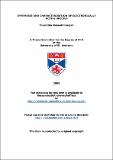Files in this item
Synthesis and characterisation of electronically active species
Item metadata
| dc.contributor.advisor | Lightfoot, Philip | |
| dc.contributor.author | Mahenthirarajah, Thushitha | |
| dc.coverage.spatial | viii, 257 | en_US |
| dc.date.accessioned | 2010-07-02T09:44:13Z | |
| dc.date.available | 2010-07-02T09:44:13Z | |
| dc.date.issued | 2009 | |
| dc.identifier.uri | https://hdl.handle.net/10023/954 | |
| dc.description.abstract | An exploration of some early transition metal (oxy) fluoride systems using solvothermal techniques has been carried out. 30 novel materials have been synthesised, which fall into three classes based on different metal centres; vanadium (21), molybdenum (5) and niobium (4). Some of these also contain secondary metal centres, namely copper (22) and zinc (1). Simultaneously, the relationship between the SHG values and the crystal structures of the hilgardites family members Pb₂B₅O₉Cl, Pb₂B₅O₉Br, Sr₂B₅O₉Cl and Ba₂B₅O₉Cl was investigated. In particular, the Pb–containing members of the hilgardite family of borate halides exhibit an abnormally large non–linear optical response, which was analysed based on neutron powder diffraction. Using solvothermal synthesis in HF–containing media, 21 novel vanadium oxyfluorides containing interesting structural features, were synthesised at 160˚C using a range of organo-amine compounds as a ligand, template, linker or structure directing agent. The architectures of the crystal structures may be categorised into; four clusters including monomeric vanadium units, five clusters including vanadium dimers, eight 1–D chains, two 2–D layers and two 3–D networks. ‘Composition–space’ diagrams with three components were used to study the effect of stoichiometry changes of reactants and to map out the crystallisation fields. The combination of early (Nb⁵⁺, Mo⁶⁺) and late (Cu²⁺) transition metals with different organo-amines produced nine novel compounds incorporating monomers, chains and 2– D interpenetrated networks. The chains and layers were synthesised from a systematic series of reactions at 160˚C and can be subdivided into four pairs, the topologies of which are essentially unique to each ligand, containing in each case a Cu–based cationic species, but alternately either [MoO₂F₄]²⁻ or [NbOF₅]²⁻, in an isomorphous manner, as the anionic moiety. The overall structures of these materials reflect the influence of the organo–amine ligands. The materials have been studied for their magnetic properties and characterised by thermogravimetric analysis, Rietveld refinement and elemental analysis where relevant. | en_US |
| dc.language.iso | en | en_US |
| dc.publisher | University of St Andrews | |
| dc.subject.lcc | QD172.T6M25 | |
| dc.subject.lcsh | Vanadium | en_US |
| dc.subject.lcsh | Molybdenum | en_US |
| dc.subject.lcsh | Niobium | en_US |
| dc.subject.lcsh | Transition metals--Analysis | en_US |
| dc.subject.lcsh | Transition metals--Synthesis | en_US |
| dc.subject.lcsh | Transition metals--Magnetic properties | en_US |
| dc.title | Synthesis and characterisation of electronically active species | en_US |
| dc.type | Thesis | en_US |
| dc.type.qualificationlevel | Doctoral | en_US |
| dc.type.qualificationname | PhD Doctor of Philosophy | en_US |
| dc.publisher.institution | The University of St Andrews | en_US |
This item appears in the following Collection(s)
Items in the St Andrews Research Repository are protected by copyright, with all rights reserved, unless otherwise indicated.

